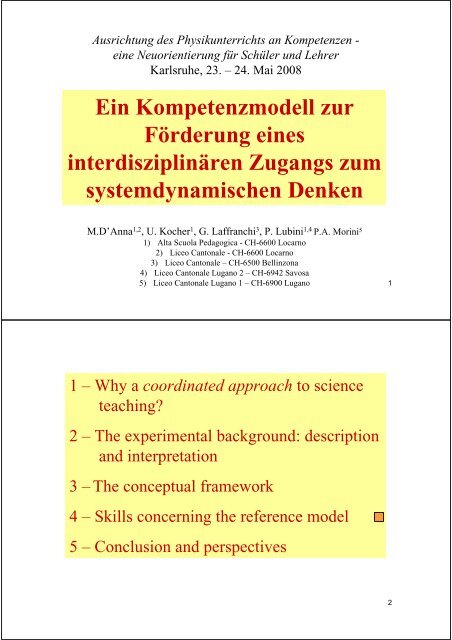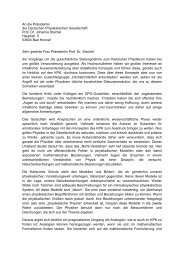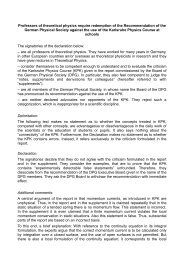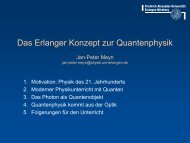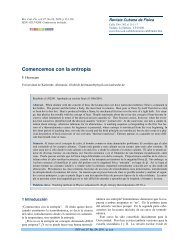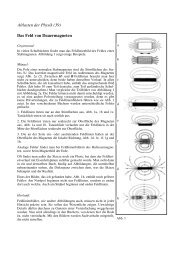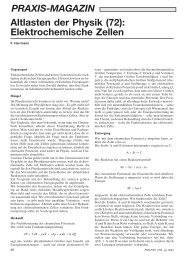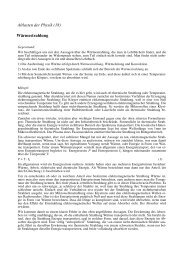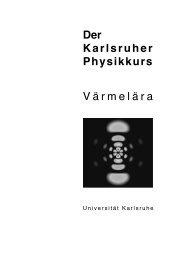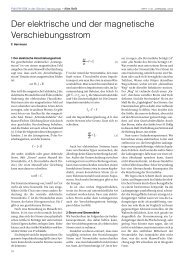Ein Kompetenzmodell zur Förderung eines interdisziplinären ...
Ein Kompetenzmodell zur Förderung eines interdisziplinären ...
Ein Kompetenzmodell zur Förderung eines interdisziplinären ...
Create successful ePaper yourself
Turn your PDF publications into a flip-book with our unique Google optimized e-Paper software.
Ausrichtung des Physikunterrichts an Kompetenzen -<br />
eine Neuorientierung für Schüler und Lehrer<br />
Karlsruhe, 23. – 24. Mai 2008<br />
<strong>Ein</strong> <strong>Kompetenzmodell</strong> <strong>zur</strong><br />
Förderung <strong>eines</strong><br />
interdisziplinären Zugangs zum<br />
systemdynamischen Denken<br />
M.D’Anna 1,2 , U. Kocher 1 , G. Laffranchi 3 , P. Lubini 1,4 P.A. Morini 5<br />
1) Alta Scuola Pedagogica - CH-6600 Locarno<br />
2) Liceo Cantonale - CH-6600 Locarno<br />
3) Liceo Cantonale – CH-6500 Bellinzona<br />
4) Liceo Cantonale Lugano 2 – CH-6942 Savosa<br />
5) Liceo Cantonale Lugano 1 – CH-6900 Lugano<br />
1<br />
1 – Why a coordinated approach to science<br />
teaching?<br />
2 – The experimental background: description<br />
and interpretation<br />
3 – The conceptual framework<br />
4 – Skills concerning the reference model<br />
5 – Conclusion and perspectives<br />
2
1 - Why a coordinated approach<br />
to science teaching?<br />
Students should have the possibility to appreciate<br />
science as a large, coherent and understandable<br />
description of natural phenomena.<br />
Science teaching therefore must be planned in such a<br />
way that students can, in fact, recognize this unity.<br />
3<br />
Biology, chemistry and physics each have their own<br />
specificities: they must be acknowledged, maintained<br />
and highlighted!<br />
But they all share a conceptual transversal scaffolding.<br />
Step by step construction of a coherent image of natural<br />
phenomena.<br />
4
A (new?) model for a coordinated approach?<br />
Propaedeutical<br />
or hierarchical<br />
model<br />
Cognitive organizers<br />
• Energy model<br />
• Corpuscular structure<br />
of matter<br />
• Concept of system<br />
Siehe Naturwissenschaften besser Verstehen – Lernhindenisse vermeiden,<br />
MNU April 2004<br />
5<br />
For each of these, we intend to elaborate a common<br />
frame of reference (knowledge and skills demanded<br />
of the pupils by the end of the basic course).<br />
The time factor and restrictions resulting from the<br />
(supposed) hierarchical relationship of one subject<br />
with respect to another can be avoided.<br />
The consistency with the agreed general model must<br />
be guaranteed by all subjects in each, single didactic<br />
action.<br />
6
Edgar Morin<br />
Die sieben Fundamente des Wissens für<br />
eine Erziehung der Zukunft<br />
Die Prinzipien einer umfassenden Erkenntnis<br />
• Es ist wichtig eine Erkenntnis zu fördern, die fähig ist,<br />
die globalen und fundamentalen Probleme zu erfassen<br />
und die Partiellen und lokalen Erkenntnisse darin zu<br />
integrieren.<br />
Aus: Edgar Morin, Die sieben Fundamente des Wissens für eine Erziehung der Zukunft, Kämer Verlag Hamburg 2001, Seite 16<br />
7<br />
• <strong>Ein</strong>e fragmentierte Erkenntnis muss einer Erkenntnis<br />
Platz machen, die die Gegenstände in ihren Kontexten,<br />
ihren Komplexen und ihren Gesamtheiten erfasst.<br />
• Es ist notwendig, alle Informationen in einen Kontext<br />
und in eine Gesamtheit zu stellen. Weiterhin ist es<br />
notwendig, Methoden zu vermitteln, die die<br />
gegenseitigen Beziehungen und <strong>Ein</strong>flüsse zwischen<br />
Teilen und Ganzem in einer komplexem Welt erfassen.<br />
Aus: Edgar Morin, Die sieben Fundamente des Wissens für eine Erziehung der Zukunft, Kämer Verlag Hamburg, 2001, Seite 16<br />
8
2 – The experimental background:<br />
description and interpretation<br />
Interaction: transfer<br />
9<br />
Interaction: transfer<br />
10
Interaction: transfer<br />
11<br />
Interaction: transfer<br />
12
Interaction: transfer<br />
13<br />
Interaction: transfer<br />
14
Processes: transfer and production / annihilation<br />
15<br />
Pumps create differences<br />
16
Processes: “machines” ...<br />
17<br />
Von der Beschreibung <strong>zur</strong> Interpretation (Modeling)<br />
Interpretation der<br />
Phänomene:<br />
Analogien als Werkzeug<br />
<strong>zur</strong> Modellbildung.<br />
18
Postazione 2<br />
Solubilità di un gas nell’acqua<br />
Introduci dell’anidride carbonica nel recipiente.<br />
È corretto aspettarsi la presenza di una spinta<br />
per il passaggio del gas in soluzione. Osserva<br />
il manometro: corrisponde alle tue previsioni?<br />
Agita vigorosamente l’ampolla: che cosa<br />
osservi?<br />
Versione alternativa: come sopra, ma<br />
impiegando una bottiglia di PET.<br />
Considera il fenomeno da un punto di vista<br />
chimico. Quale potrebbe essere la descrizione<br />
in termini di quantità di sostanza, potenziale<br />
chimico e equazione di bilancio?<br />
Rappresenta il potenziale chimico per la CO 2<br />
nelle due fasi in funzione del tempo.<br />
19<br />
Systemdynamische Modellierung:<br />
Das Grundschema<br />
20
Model results: chemical potential vs. time<br />
-3.94e+5<br />
-3.95e+5<br />
-3.96e+5<br />
mu_gas, mu_aq<br />
-3.97e+5<br />
-3.98e+5<br />
mu_gas:1<br />
mu_aq:1<br />
-3.99e+5<br />
-4e+5<br />
-4.01e+5<br />
0<br />
5<br />
10<br />
15<br />
TIME<br />
20<br />
25<br />
30<br />
21<br />
Model results: amount of substance vs. time<br />
0.03<br />
0.027<br />
0.024<br />
0.021<br />
n_aq:1<br />
n_gas:1<br />
n_aq, n_gas<br />
0.018<br />
0.015<br />
0.012<br />
0.009<br />
0.006<br />
0.003<br />
0<br />
0<br />
5<br />
10<br />
15<br />
TIME<br />
20<br />
25<br />
30<br />
22
Systemdynamische Modellierung:<br />
Das Grundschema<br />
Anelastischer Stoss<br />
23<br />
Systemdynamische Modellierung:<br />
Das Grundschema<br />
24
Systemdynamische Modellierung:<br />
Das Grundschema<br />
25<br />
Systemdynamische Modellierung:<br />
Das Grundschema<br />
26
27<br />
28
3 – The conceptual framework<br />
Extensive physical quantity<br />
• can be stored<br />
• can be transferred from a system to another<br />
• are submitted to a balance equation<br />
Intensive quantities<br />
whose differences represent the “driving forces” for<br />
physical processes<br />
In addition, in order to obtain a suitable quantitative description<br />
of the observed phenomena it is necessary to introduce also the<br />
concepts of resistance and capacitance<br />
29<br />
Mengenartige<br />
Grösse<br />
Erhalten /<br />
NICHT<br />
erhalten<br />
Intensität des<br />
zugeordneten<br />
Stromes<br />
Potential<br />
Antrieb<br />
Hydraulik<br />
Volumen<br />
V<br />
erhalten<br />
Wasser Strom<br />
I V<br />
Druck P<br />
∆P<br />
Elektrizität<br />
Elektrische<br />
Ladung Q<br />
erhalten<br />
Elektrischer Strom<br />
I Q<br />
Elektrisches<br />
Potential ϕ<br />
∆ϕ<br />
Mechanik<br />
Translationen<br />
Impuls<br />
p x<br />
erhalten<br />
Mechanischer<br />
Strom<br />
(Translationen) I px<br />
(oder Kraft F)<br />
Geschwindigkeit<br />
v x<br />
∆v x<br />
Mechanik<br />
Rotationen<br />
Drall L x<br />
erhalten<br />
Mechanischer<br />
Strom (Rotationen)<br />
I Lx<br />
oder Moment M mecc<br />
Winkelgeschwindigkeit<br />
ω x<br />
∆ω x<br />
Wärmelehre<br />
Entropie S<br />
NICHT<br />
erhalten<br />
Entropiestrom<br />
I S<br />
Absolute<br />
Temperatur<br />
T<br />
∆T<br />
Chemie<br />
Stoffmenge<br />
n<br />
NICHT<br />
erhalten<br />
Chemischer Strom<br />
I n<br />
Chemisches<br />
Potential µ<br />
∆µ<br />
30
Bilanzgesetz<br />
Momentane Form des<br />
Bilanzgesetzes<br />
(Kontinuitätsgleichung)<br />
dX<br />
= I +π X X<br />
dt<br />
dX<br />
dt<br />
I X<br />
π X<br />
X: Mass für die mengenartige<br />
Grösse X<br />
I X : Mass für die Intensität des<br />
Austausches<br />
π X :Mass für die Erzeugungs- /<br />
Vernichtungsrate<br />
31<br />
Bilanzgleichung<br />
Hydraulik<br />
dV/dt = I V<br />
Elektrizität<br />
Mechanik<br />
dQ/dt = I Q<br />
dp/dt = I p = F<br />
Wärmelehre<br />
dS/dt = I S + π S<br />
Chemie<br />
dn/dt = I n + π n<br />
32
<strong>Ein</strong> Energiemodell<br />
Energie<br />
kann gespeichert werden;<br />
kann von einem System zu einem anderen übertragen<br />
werden;<br />
beim Fliessen ist sie immer an einen Träger gebunden;<br />
kann von einem Träger zu einem anderen umgeladen<br />
werden;<br />
ist eine bilanzierbare Grösse;<br />
ist eine erhaltene Grösse.<br />
33<br />
Energie Transport<br />
I = I ⋅ϕ<br />
E X X<br />
Energie Umladung<br />
P = I ⋅∆ϕ<br />
X<br />
X<br />
34
Mengenartige<br />
Grösse<br />
Potential<br />
Intensität des<br />
zugeordneten Stromes<br />
Energie<br />
Transport<br />
Energie<br />
Umladung<br />
Hydraulik<br />
Volumen<br />
V<br />
Druck p<br />
Wasserstrom<br />
I V<br />
I E = I V ⋅ p<br />
P = I V ⋅ ∆p<br />
Elektrizität<br />
Elektrische<br />
Ladung Q<br />
Elektrisches<br />
Potential ϕ<br />
Elektrischer Strom I Q<br />
I E = I Q ⋅ϕ<br />
P = I Q ⋅∆ϕ<br />
Mechanik<br />
Translationen<br />
Impuls<br />
p x<br />
Geschwindigkeit<br />
v x<br />
Mechanischer Strom<br />
(Translationen) I px<br />
(oder Kraft F)<br />
I E = I px ⋅v x<br />
P = I px ⋅∆v x<br />
Mechanik<br />
Rotationen<br />
Drall L x<br />
Winkelgeschwindigkeit<br />
ω x<br />
Mechanischer Strom<br />
(Rotationen) I Lx<br />
(oder Moment M mecc )<br />
I E = I Lx ⋅ω x<br />
P = I Lx ⋅∆ω x<br />
Wärmelehre<br />
Entropie S<br />
Absolute<br />
Temperatur<br />
T<br />
Entropiestrom<br />
I S<br />
I E = I S ⋅T<br />
P = I S ⋅∆T<br />
Chemie<br />
Stoffmenge<br />
n<br />
Chemisches<br />
Potential µ<br />
Chemischer Strom I n<br />
bzw.<br />
Produktionsrate π n(R)<br />
I E = I n ⋅µ<br />
P = I n ⋅∆µ<br />
P = π n(R) ⋅∆µ<br />
35<br />
Graphical representation: process diagrams<br />
I x, in<br />
∆ϕx<br />
I x, out<br />
ϕ x, in<br />
ϕ x, out<br />
I x,in = |I x, out |<br />
36
Graphical representation: process diagrams<br />
I E, in<br />
I x, in<br />
ϕ x, in<br />
∆ϕ<br />
x<br />
P<br />
ϕ x, out<br />
I E, out<br />
I x, out<br />
Energy balance<br />
P= I <strong>Ein</strong> ,<br />
− I Eout ,<br />
37<br />
Graphical representation: process diagrams<br />
I E, in<br />
I x, in<br />
I x, out<br />
P<br />
ϕ x, in<br />
I E, out<br />
ϕx, out<br />
Energy balance<br />
P= I<br />
<strong>Ein</strong> , −<br />
I<br />
Eout<br />
,<br />
38
Graphical representation: process diagrams<br />
Example: electric motor (ideal)<br />
I E el, in<br />
I E mecc<br />
I Q, in<br />
I L, out<br />
P el = P mecc<br />
ω out<br />
I Q, out<br />
ω = 0<br />
in<br />
I L,in<br />
ϕ el, in<br />
I E el, out<br />
ϕel, out<br />
I<br />
Energy balance: E mecc<br />
= IEel,in−<br />
IEel,out<br />
39<br />
Exemple: modèle didactique<br />
Hypothèse:<br />
Efficience 100 %<br />
Tous les processus<br />
sont réversibles:<br />
π s<br />
= 0 J/(K.s)<br />
Energie Energie Energie Energie Energie<br />
Lumière<br />
Électricité<br />
Substances<br />
H 2<br />
, O 2<br />
Électricité<br />
P el<br />
P chim P el P mecc<br />
P H lum P 2<br />
O<br />
el<br />
P chim P el<br />
Moment angulaire<br />
Cellule<br />
fotovoltaique<br />
Cellule<br />
électrolitique<br />
Cellule<br />
combustibile<br />
Moteur électrique<br />
Potentiel<br />
électrique<br />
Potentiel<br />
chimique<br />
Potentiel<br />
électrique<br />
Potentiel<br />
mécanique<br />
40
4 - Skills concerning the reference model<br />
1 - When faced with a given experimental situation, the<br />
student must be able to:<br />
1.1 - sketch out the description on a phenomenological level,<br />
singling out accurately the physical system to be examined, the<br />
fundamental quantities to be taken into consideration as well as<br />
the exchanges with the surroundings and the production<br />
/destruction processes which may occur within the system;<br />
41<br />
1.2 - recognize the role of the differences of generalized<br />
potentials as “driving forces” for the transfer processes of a<br />
conductive nature;<br />
∆p<br />
1.3 -usethe concepts of capacity and resistance to interpret<br />
qualitatively the development observed over a period of time;<br />
42
1.4 - outline the energy balance in terms of incoming and<br />
outgoing energy flows; in particular single out, in a given<br />
process, the transfer of energy from one energy carrier to<br />
another;<br />
1.5 - recognize, how one potential difference can be used to<br />
create another one by releasing energy used by the second<br />
process, both in nature and in technical artefacts;<br />
43<br />
1.6 - identify those processes in which entropy is typically<br />
produced, as well as the link between entropy production and<br />
irreversibility.<br />
44
2 - With respect to the quantitative treatment of different<br />
fields, the student must be able to:<br />
2.1 - know and use the extensive and intensive quantities, their<br />
units of measurement (SI) and the basic relationships which<br />
link them (constitutive laws for some simple systems);<br />
2.2 - characterize equilibrium in terms of intensive quantities;<br />
-3.94e+5<br />
-3.95e+5<br />
-3.96e+5<br />
mu_gas, mu_aq<br />
-3.97e+5<br />
-3.98e+5<br />
mu_gas:1<br />
mu_aq:1<br />
-3.99e+5<br />
-4e+5<br />
-4.01e+5<br />
0<br />
5<br />
10<br />
15<br />
TIME<br />
20<br />
25<br />
30<br />
45<br />
2.3 - set up accurately the balance equation (both in its instantaneous<br />
and integrated forms) and apply it to describe situations<br />
observed and to predict the development of the system;<br />
2.4 - know and use the connection between the magnitude of the<br />
flows and the level of the potentials at which the transport<br />
occurs and the magnitude of the energy flows and of the power<br />
released and/or required in a given process;<br />
2.5 - know and use the relation between the dissipation rate of<br />
energy and the production rate of entropy.<br />
π = P<br />
S<br />
el<br />
T heater<br />
46
3 - The student must also be able to:<br />
3.1 - obtain and use quantitative data from diagrams<br />
plotting the relationships between physical quantities<br />
(particularly in connection with time elapsed);<br />
2.5<br />
Pressione relativa [ kPa ]<br />
2<br />
1.5<br />
1<br />
0.5<br />
0<br />
0<br />
20<br />
40<br />
60<br />
80 100<br />
tempo [ s ]<br />
120<br />
140<br />
160<br />
180<br />
Quale dei due vasi era stato riempito con acqua all’inizio dell’esperimento?<br />
47<br />
3.2 -deducefrom diagrams of stored quantities as<br />
functions of time information about the magnitudes of<br />
incoming and outgoing flows and vice versa;<br />
0.03<br />
0.027<br />
0.024<br />
0.021<br />
n_aq:1<br />
n_gas:1<br />
n_aq, n_gas<br />
0.018<br />
0.015<br />
0.012<br />
0.009<br />
0.006<br />
0.003<br />
0<br />
0<br />
5<br />
10<br />
15<br />
TIME<br />
20<br />
25<br />
30<br />
CO<br />
<br />
CO<br />
2( g) 2( aq)<br />
3.3 - read and use process diagrams that graphically<br />
represent various processes;<br />
48
3.4 - recognize and make explicit the analogies between<br />
situations in different fields of study;<br />
dV/dt = I V<br />
dp/dt = F<br />
dn/dt = I n + π n<br />
50<br />
49<br />
3.5 - imagine and describe experimental situations by analogy.<br />
Hydraulik<br />
Elektrizität<br />
Mechanik<br />
Wärmelehre<br />
Chemie
5 – Conclusions and perspectives<br />
Choices on the<br />
disciplinary level<br />
Modeling<br />
(mathematical level)<br />
On-line data acquisition<br />
(experimental level)<br />
51<br />
An example: a titration experiment – description and interpretation<br />
HCl + NaOH ⎯⎯→ H O + NaCl<br />
( aq) ( aq) 2 ( l) ( aq)<br />
pH<br />
52
A model with chemical potential<br />
H + OH ⎯⎯→ H O<br />
+ −<br />
( aq) ( aq) 2 ( l )<br />
53<br />
Measured values (black) vs. model results (red)<br />
14<br />
12<br />
10<br />
pH, #a_pH2<br />
8<br />
6<br />
4<br />
2<br />
0<br />
0<br />
100<br />
200<br />
300<br />
400<br />
500<br />
TIME<br />
600<br />
700<br />
800<br />
900<br />
1000<br />
54
Some references<br />
• Morin E, (2000) Les sept savoir nécesaires à l‘éducation du futur, Seuil;<br />
• Herrmann F, (2005) Der Karlsruher Physikkurs Aulis Verlag, Köln<br />
• Herrmann F, (2006). Was ist eine mengenartige Grösse?, Praxis der Naturwissenschaften - Physik<br />
55(1): 44-46<br />
• Herrmann F, (2005). Le KPK – un cours de physique basé sur des analogies, Bulletin de l’Union<br />
des Physiciens 99(870): 43 - 58.<br />
• Herrmann F, Job G, (1996). The historical burden on scientific knowledge, European Journal of<br />
Physics 17: 159;<br />
• Herrmann F, Job G, (2002) Altlasten der Physik, Aulis Verlag, Köln;<br />
• Ferbar J, (1996). Irresistibility of irreversibility, Proceedings GIREP Conference New ways of<br />
teaching physics, Ljubljana, Slovenia;<br />
• Job G, (1972). Neudarstellung der Wärmelehre - Die Entropie als Wärme, Frankfurt am Main,<br />
Akademische Verlagsgesellschaft;<br />
• Fuchs H U, (1996). The dynamics of heat New York, Springer.<br />
• Fuchs H U, (2002). Modeling of uniform dynamical systems, Zürich, Orell Füssli.<br />
• Borer T et al, (2005). Physik - <strong>Ein</strong> systemdynamischer Zugang für die Sekundarstufe II. Bern,<br />
h.e.p.<br />
55<br />
Besten Dank<br />
für Ihre Aufmerksamkeit!<br />
Contact address:<br />
danna@liceolocarno.ch<br />
urs.kocher@aspti.ch<br />
laffranc@liceobellinzona.ch<br />
plubini@bluewin.ch<br />
ppma.morini@bluewin.ch<br />
56
Gruppo di ricerca September 2007<br />
L’insegnamento della termodinamica nella scuola medio superiore<br />
Skills concerning the reference model<br />
(preliminary version for the 2007-2008 activity)<br />
1. When faced with a given experimental situation, the student must be able to:<br />
1.1 sketch out the description on a phenomenological level, singling out accurately the physical<br />
system to be examined, the fundamental quantities to be taken into consideration as well as the<br />
exchanges with the surroundings and the production/destruction processes which may occur<br />
within the system;<br />
1.2 recognize the role of the differences of generalized potentials as “driving forces” for the transfer<br />
processes of a conductive nature;<br />
1.3 use the concepts of capacity and resistance to interpret qualitatively the development observed<br />
over a period of time;<br />
1.4 outline the energy balance in terms of incoming and outgoing energy flows; in particular single<br />
out , in a given process, the transfer of energy from one energy carrier to another;<br />
1.5 recognize, how one potential difference can be used to create another one by releasing energy<br />
used by the second process, both in nature and in technical artefacts;<br />
1.6 identify those processes in which entropy is typically produced, as well as the link between<br />
entropy production and irreversibility.<br />
2. With respect to the quantitative treatment of different fields, the student must be able to:<br />
2.1 know and use the extensive and intensive quantities, their units of measurement (SI) and the<br />
basic relationships which link them (constitutive laws for some simple systems);<br />
2.2 characterize equilibrium in terms of intensive quantities;<br />
2.3 set up accurately the balance equation (both in its instantaneous and integrated forms) and apply<br />
it to describe situations observed and to predict the development of the system;<br />
2.4 know and use the connection between the magnitude of the flows and the level of the potentials<br />
at which the transport occurs and the magnitude of the energy flows and of the power released<br />
and/or required in a given process;<br />
2.5 know and use the relation between the dissipation rate of energy and the production rate of<br />
entropy.<br />
3. The student must also be able to:<br />
3.1 obtain and use quantitative data from diagrams plotting the relationships between physical<br />
quantities (particularly in connection with time elapsed);<br />
3.2 deduce from diagrams of stored quantities as functions of time information about the<br />
magnitudes of incoming and outgoing flows and vice versa;<br />
3.3 read and use process diagrams that graphically represent various processes;<br />
3.4 recognize and make explicit the analogies between situations in different fields of study;<br />
3.5 imagine and describe experimental situations by analogy.


